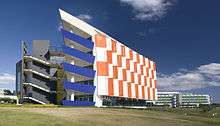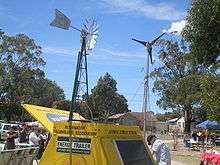Green building in Australia
Green buildings in Australia are assessed and rated by a variety of government and independent ratings systems.
The Green Building Council of Australia (GBCA) has developed a green building standard known as Green Star, with the first Green Star rating in Australia awarded to 8 Brindabella Circuit at Canberra Airport in 2004.[1][2] As of April 2013, over 550 projects have been Green-Star certified, representing 8 million square metres of gross floor area and over 20% of Australia's CBD office space.[3]
EER: Energy Efficiency Rating launched in 1996 and in Australia is a system ranging from 0-10 stars and mandatory for buildings in the Australian Capital Territory (ACT) region
The Green Star environmental rating tools for buildings benchmark the potential of buildings based on nine environmental impact categories: Management; Indoor Environment Quality; Energy; Transport; Water; Materials; Land Use & Ecology; Emissions and Innovation. Green Star also has a tool which focuses on neighborhood development.

The National Australian Built Environment Rating System (NABERS), is a government initiative to measure and compare the environmental performance of Australian buildings. The NABERS ratings for office buildings include: Energy; Water; Waste and Indoor environment.
A rating for transport is also in development. Together, these ratings can provide a comprehensive picture of the sustainability performance of office buildings and tenancies. Ratings are also available for homes and hotels. Retail and hospital ratings will be launched later this year.
History
The Green Building Council of Australia has certified more than 600 buildings around Australia, among them the 6 Green Star certification of Trevor Pearcey House in Canberra, the refurbished facility of Australian Ethical Investment Ltd.[4] The total cost of the renovation was $1.7 million, and produced an estimated 75% reductions in carbon dioxide emissions, 75% reduction in water usage, and used over 80% recycled materials. The architects were Collard Clarke Jackson Canberra, architectural work done by Kevin Miller, interior design by Katy Mutton.[5]
Statewide developments
New South Wales
In NSW, an on-line assessment system called BASIX (Building Sustainability Index) requires that all new residential developments to reduce water consumption by 40%, and CO2 emissions by 40% for detached dwellings and between 20 and 30% for multi unit dwellings compared to an average baseline. The online system provides designers with a mathematical model of the development that considered the interactions between the energy and water systems of the whole, drawing on climatic and normalised rainfall data for individual locations.
South Australia
Guidelines for building developments in each project are outlined in the bylaws. The bylaws include various permutations of grey water reuse, reuse of stormwater, capture of rainwater, use of solar panels for electricity and hotwater, solar passive building design and community gardens and landscaping.
Victoria

Melbourne has a rapidly growing environmental consciousness, many government subsidies and rebates are available for water tanks, water efficient products (such as shower heads) and solar hot water systems.
Western Australia
In Perth, Western Australia, there are at least three different projects that incorporate the principles of green building. The Office development located in Murray Street, West Perth being designed by Eco Design Consultant in collaboration with Troppo Architects is one of them. The other two are mixed development along Wellington Street, in the city centre. Guidelines for building developments in each project are outlined in the bylaws and the Green Building Council of Australia.
References
- "Green Building Council Of Australia". Archived from the original on 2008-07-05. Retrieved 2009-05-02.
- "The Hub, Canberra Airport, November 2004" (PDF). Archived from the original (PDF) on 2009-03-20. Retrieved 2009-05-02.
- "Green and Sustainable Building". Australian Government - Australian Trade Commission. April 2013. Retrieved 7 July 2016.
- "Australian Ethical Investment Ltd". Archived from the original on 2008-12-26. Retrieved 2009-05-02.
- "Collard Clarke Jackson Canberra". Archived from the original on 2008-12-26. Retrieved 2009-05-02.
Further reading
- DETR, (2000). “Building a better quality of life: A Strategy for more Sustainable Construction.” Department of Environment, Transport & Regions, UK.
- Taylor, Robin (April–May 2009). "Old buildings take the green lead" (PDF). ECOS (148): 24–27. Retrieved 2009-05-03.